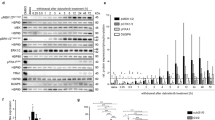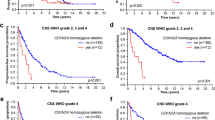Abstract
Neuroblastoma is the most common extracranial solid tumor in children and tumor ganglioside composition has been linked to its biological and clinical behavior. We recently found that high expression of complex gangliosides that are products of the enzyme GM1a/GD1b synthase predicts a more favorable outcome in human neuroblastoma, and others have shown that complex gangliosides such as GD1a inhibit metastasis of murine tumors. To determine how a switch from structurally simple to structurally complex ganglioside expression affects neuroblastoma cell behavior, we engineered IMR32 human neuroblastoma cells, which contain almost exclusively (89%) the simple gangliosides (SG) GM2, GD2, GM3, and GD3, to overexpress the complex gangliosides (CG) GM1, GD1a, GD1b and GT1b, by stable retroviral-mediated transduction of the cDNA encoding GM1a/GD1b synthase. This strikingly altered cellular ganglioside composition without affecting total ganglioside content: There was a 23-fold increase in the ratio of complex to simple gangliosides in GM1a/GD1b synthase-transduced cells (IMR32-CG) vs. wild type (IMR32) or vector-transfected (IMR32-V) cells with essentially no expression of the clinical neuroblastoma marker, GD2, confirming effectiveness of this molecular switch from simple to complex ganglioside synthesis. Probing for consequences of the switch, we found that among functional properties of IMR32-CG cells, cell migration was inhibited and Rho/Rac1 activities were altered, while proliferation kinetics and cell differentiation were unaffected. These findings further implicate cellular ganglioside composition in determining cell migration characteristics of tumor cells. This IMR32 model system should be useful in delineating the impact of ganglioside composition on tumor cell function.





Similar content being viewed by others
References
Gurney, J.G., Ross, J.A., Wall, D.A., Bleyer, W.A., Severson, R.K., Robison, L.L.: Infant cancer in the U.S.: histology-specific incidence and trends, 1973 to 1992. J. Pediatr. Hematol./Oncol. 19, 428–432 (1997)
Bonilla, M.A., Cheung, N.K.: Clinical progress in neuroblastoma. Cancer Investig. 12, 644–653 (1994)
Valentino, L., Moss, T., Olson, E., Wang, H.J., Elashoff, R., Ladisch, S.: Shed tumor gangliosides and progression of human neuroblastoma. Blood 75, 1564–1567 (1990)
Ladisch, S., Gillard, B., Wong, C., Ulsh, L.: Shedding and immunoregulatory activity of YAC-1 lymphoma cell gangliosides. Cancer Res. 43, 3808–3813 (1983)
van Echten, G., Sandhoff, K.: Ganglioside metabolism. Enzymology, topology, and regulation. J. Biol. Chem. 268, 5341–5344 (1993)
Portoukalian, J., Zwingelstein, G., Dore, J.F.: Lipid composition of human malignant melanoma tumors at various levels of malignant growth. Eur. J. Biochem. 94, 19–23 (1979)
Schengrund, C.L., Shochat, S.J.: Gangliosides in neuroblastomas. Neurochem. Pathol. 8, 189–202 (1988)
Tsuchida, T., Saxton, R.E., Morton, D.L., Irie, R.F.: Gangliosides of human melanoma. J. Natl Cancer Inst. 78, 45–54 (1987)
Wu, Z.L., Schwartz, E., Seeger, R., Ladisch, S.: Expression of GD2 ganglioside by untreated primary human neuroblastomas. Cancer Res. 46, 440–443 (1986)
Sung, C.C., Pearl, D.K., Coons, S.W., Scheithauer, B.W., Johnson, P.C., Zheng, M., Yates, A.J.: Correlation of ganglioside patterns of primary brain tumors with survival. Cancer 75, 851–859 (1995)
Yates, A.J., Comas, T., Scheithauer, B.W., Burger, P.C., Pearl, D.K.: Glycolipid markers of astrocytomas and oligodendrogliomas. J. Neuropathol. Exp. Neurol. 58, 1250–1262 (1999)
Hettmer, S., Malott, C., Woods, W., Ladisch, S., Kaucic, K.: Biological stratification of human neuroblastoma by complex “B” pathway ganglioside expression. Cancer Res. 63, 7270–7276 (2003)
Schengrund, C.L., Repman, M.A., Shochat, S.J.: Ganglioside composition of human neuroblastomas. Correlation with prognosis. A Pediatric Oncology Group Study. Cancer 56, 2640–2646 (1985)
Kanda, N., Nakai, K., Watanabe, S.: Gangliosides GD1b, GT1b, and GQ1b suppress the growth of human melanoma by inhibiting interleukin-8 production: the inhibition of adenylate cyclase. J. Invest. Dermatol. 117, 284–293 (2001)
Leskawa, K.C., Hogan, E.L.: Quantitation of the in vitro neuroblastoma response to exogenous, purified gangliosides. J. Neurosci. Res. 13, 539–550 (1985)
Mirkin, B.L., Clark, S.H., Zhang, C.: Inhibition of human neuroblastoma cell proliferation and EGF receptor phosphorylation by gangliosides GM1, GM3, GD1A and GT1B. Cell Prolif. 35, 105–115 (2002)
Rebhan, M., Vacun, G., Bayreuther, K., Rosner, H.: Altered ganglioside expression by SH-SY5Y cells upon retinoic acid-induced neuronal differentiation. Neuroreport 5, 941–944 (1994)
Hu, D., Man, Z., Wang, P., Tan, X., Wang, X., Takaku, S., Hyuga, S., Sato, T., Yao, X., Yamagata, S., Yamagata, T.: Ganglioside GD1a negatively regulates matrix metalloproteinase-9 expression in mouse FBJ cell lines at the transcriptional level. Connect. Tissue Res. 48, 198–205 (2007)
Hyuga, S., Yamagata, S., Takatsu, Y., Hyuga, M., Nakanishi, H., Furukawa, K., Yamagata, T.: Suppression by ganglioside GD1A of migration capability, adhesion to vitronectin and metastatic potential of highly metastatic FBJ-LL cells. Int. J. Cancer 83, 685–691 (1999)
Zhang, Q., Furukawa, K., Chen, H.H., Sakakibara, T., Urano, T.: Metastatic potential of mouse Lewis lung cancer cells is regulated via ganglioside GM1 by modulating the matrix metalloprotease-9 localization in lipid rafts. J. Biol. Chem. 281, 18145–18155 (2006)
Ladisch, S., Gillard, B.: A solvent partition method for microscale ganglioside purification. Anal. Biochem. 146, 220–231 (1985)
Li, R.X., Ladisch, S.: Shedding of human neuroblastoma gangliosides. Biochim. Biophys. Acta 1083, 57–64 (1991)
Hettmer, S., Ladisch, S., Kaucic, K.: Low complex ganglioside expression characterizes human neuroblastoma cell lines. Cancer Lett. 225, 141–149 (2005)
De Laurenzi, V., Raschella, G., Barcaroli, D., Annicchiarico-Petruzzelli, M., Ranalli, M., Catani, M.V., Tanno, B., Costanzo, A., Levrero, M., Melino, G.: Induction of neuronal differentiation by p73 in a neuroblastoma cell line. J. Biol. Chem. 275, 15226–15231 (2000)
Hanada, M., Krajewski, S., Tanaka, S., Cazals-Hatem, D., Spengler, B.A., Ross, R.A., Biedler, J.L., Reed, J.C.: Regulation of Bcl-2 oncoprotein levels with differentiation of human neuroblastoma cells. Cancer Res. 53, 4978–4986 (1993)
Pahlman, S., Hoehner, J.C., Nanberg, E., Hedborg, F., Fagerstrom, S., Gestblom, C., Johansson, I., Larsson, U., Lavenius, E., Ortoft, E., et al.: Differentiation and survival influences of growth factors in human neuroblastoma. Eur. J. Cancer 31A, 453–458 (1995)
Guan, J.L.: Cell biology. Integrins, rafts, Rac, and Rho. Science 303, 773–774 (2004)
Palazzo, A.F., Eng, C.H., Schlaepfer, D.D., Marcantonio, E.E., Gundersen, G.G.: Localized stabilization of microtubules by integrin- and FAK-facilitated Rho signaling. Science 303, 836–839 (2004)
Wang, L., Wang, Y., Sato, T., Yamagata, S., Yamagata, T.: Ganglioside GD1a suppresses TNFalpha expression via Pkn1 at the transcriptional level in mouse osteosarcoma-derived FBJ cells. Biochem. Biophys. Res. Commun. 371, 230–235 (2008)
Cazet, A., Groux-Degroote, S., Teylaert, B., Kwon, K.M., Lehoux, S., Slomianny, C., Kim, C.H., Le Bourhis, X., Delannoy, P.: GD3 synthase overexpression enhances proliferation and migration of MDA-MB-231 breast cancer cells. Biol. Chem. 390, 601–609 (2009)
Prinetti, A., Aureli, M., Illuzzi, G., Prioni, S., Nocco, V., Scandroglio, F., Gagliano, N., Tredici, G., Rodriguez-Menendez, V., Chigorno, V., Sonnino, S.: GM3 synthase overexpression results in reduced cell motility and in caveolin-1 up-regulation in human ovarian carcinoma cells. Glycobiology 20, 62–77 (2009)
Mutoh, T., Hamano, T., Yano, S., Koga, H., Yamamoto, H., Furukawa, K., Ledeen, R.W.: Stable transfection of GM1 synthase gene into GM1-deficient NG108-15 cells, CR-72 cells, rescues the responsiveness of Trk-neurotrophin receptor to its ligand, NGF. Neurochem. Res. 27, 801–806 (2002)
Khanna, C., Jaboin, J.J., Drakos, E., Tsokos, M., Thiele, C.J.: Biologically relevant orthotopic neuroblastoma xenograft models: primary adrenal tumor growth and spontaneous distant metastasis. In Vivo 16, 77–85 (2002)
Zeng, G., Gao, L., Yu, R.K.: Reduced cell migration, tumor growth and experimental metastasis of rat F-11 cells whose expression of GD3-synthase is suppressed. Int. J. Cancer 88, 53–57 (2000)
Gu, Y., Zhang, J., Mi, W., Yang, J., Han, F., Lu, X., Yu, W.: Silencing of GM3 synthase suppresses lung metastasis of murine breast cancer cells. Breast Cancer Res. 10, R1 (2008)
Paller, A.S., Arnsmeier, S.L., Chen, J.D., Woodley, D.T.: Ganglioside GT1b inhibits keratinocyte adhesion and migration on a fibronectin matrix. J. Invest. Dermatol. 105, 237–242 (1995)
Lang, Z., Guerrera, M., Li, R., Ladisch, S.: Ganglioside GD1a enhances VEGF-induced endothelial cell proliferation and migration. Biochem. Biophys. Res. Commun. 282, 1031–1037 (2001)
Mukherjee, P., Faber, A.C., Shelton, L.M., Baek, R.C., Chiles, T.C., Seyfried, T.N.: Ganglioside GM3 suppresses the pro-angiogenic effects of vascular endothelial growth factor and ganglioside GD1A. J. Lipid Res. 49, 929–938 (2008)
Bennaceur, K., Popa, I., Portoukalian, J., Berthier-Vergnes, O., Peguet-Navarro, J.: Melanoma-derived gangliosides impair migratory and antigen-presenting function of human epidermal Langerhans cells and induce their apoptosis. Int. Immunol. 18, 879–886 (2006)
Wang, X.Q., Sun, P., Paller, A.S.: Ganglioside GM3 inhibits matrix metalloproteinase-9 activation and disrupts its association with integrin. J. Biol. Chem. 278, 25591–25599 (2003)
Ono, M., Handa, K., Sonnino, S., Withers, D.A., Nagai, H., Hakomori, S.: GM3 ganglioside inhibits CD9-facilitated haptotactic cell motility: coexpression of GM3 and CD9 is essential in the downregulation of tumor cell motility and malignancy. Biochemistry 40, 6414–6421 (2001)
Cox, E.A., Sastry, S.K., Huttenlocher, A.: Integrin-mediated adhesion regulates cell polarity and membrane protrusion through the Rho family of GTPases. Mol. Biol. Cell 12, 265–277 (2001)
Salhia, B., Rutten, F., Nakada, M., Beaudry, C., Berens, M., Kwan, A., Rutka, J.T.: Inhibition of Rho-kinase affects astrocytoma morphology, motility, and invasion through activation of Rac1. Cancer Res. 65, 8792–8800 (2005)
Nobes, C.D., Hall, A.: Rho GTPases control polarity, protrusion, and adhesion during cell movement. J. Cell Biol. 144, 1235–1244 (1999)
Raftopoulou, M., Hall, A.: Cell migration: Rho GTPases lead the way. Dev. Biol. 265, 23–32 (2004)
Ridley, A.J.: Rho GTPases and cell migration. J. Cell Sci. 114, 2713–2722 (2001)
Nobes, C.D., Hall, A.: Rho, rac, and cdc42 GTPases regulate the assembly of multimolecular focal complexes associated with actin stress fibers, lamellipodia, and filopodia. Cell 81, 53–62 (1995)
Dong, Y., Ikeda, K., Hamamura, K., Zhang, Q., Kondo, Y., Matsumoto, Y., Ohmi, Y., Yamauchi, Y., Furukawa, K., Taguchi, R.: GM1/GD1b/GA1 synthase expression results in the reduced cancer phenotypes with modulation of composition and raft-localization of gangliosides in a melanoma cell line. Cancer Sci. 101, 2039–2047 (2010)
Hettmer, S., McCarter, R., Ladisch, S., Kaucic, K.: Alterations in neuroblastoma ganglioside synthesis by induction of GD1b synthase by retinoic acid. Br. J. Cancer 91, 389–397 (2004)
Cernaianu, G., Brandmaier, P., Scholz, G., Ackermann, O.P., Alt, R., Rothe, K., Cross, M., Witzigmann, H., Trobs, R.B.: All-trans retinoic acid arrests neuroblastoma cells in a dormant state. Subsequent nerve growth factor/brain-derived neurotrophic factor treatment adds modest benefit. J. Pediatr. Surg. 43, 1284–1294 (2008)
Matthay, K.K., Villablanca, J.G., Seeger, R.C., Stram, D.O., Harris, R.E., Ramsay, N.K., Swift, P., Shimada, H., Black, C.T., Brodeur, G.M., Gerbing, R.B., Reynolds, C.P.: Treatment of high-risk neuroblastoma with intensive chemotherapy, radiotherapy, autologous bone marrow transplantation, and 13-cis-retinoic acid. Children’s Cancer Group. N. Engl. J. Med. 341, 1165–1173 (1999)
Acknowledgements
We are grateful to Su Yan, Liangping Yuan, and Michael Weiss for their assistance in this work. This work was supported by National Institutes of Health grants R01 CA 61010 (S.L.) and R01 CA106532 (K.K., S.L.).
Author information
Authors and Affiliations
Corresponding author
Rights and permissions
About this article
Cite this article
Dong, L., Liu, Y., Colberg-Poley, A.M. et al. Induction of GM1a/GD1b synthase triggers complex ganglioside expression and alters neuroblastoma cell behavior; a new tumor cell model of ganglioside function. Glycoconj J 28, 137–147 (2011). https://doi.org/10.1007/s10719-011-9330-9
Received:
Revised:
Accepted:
Published:
Issue Date:
DOI: https://doi.org/10.1007/s10719-011-9330-9




